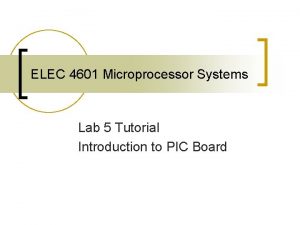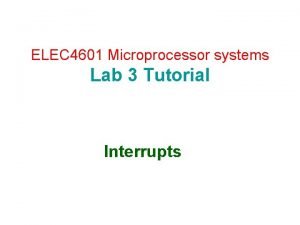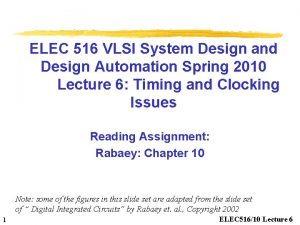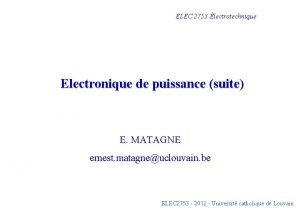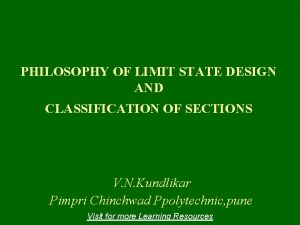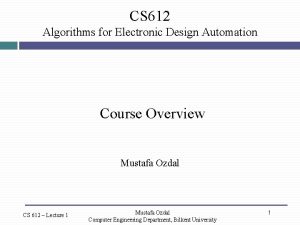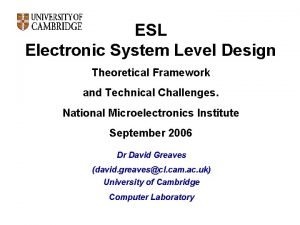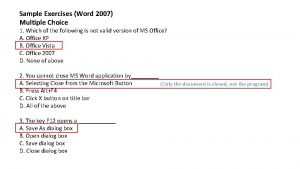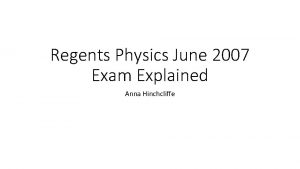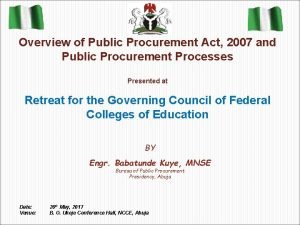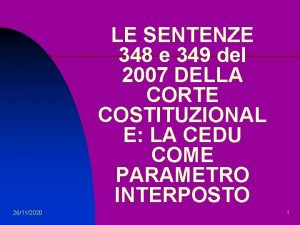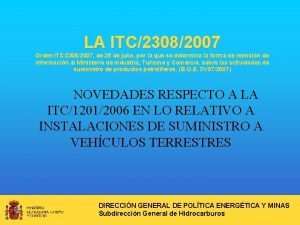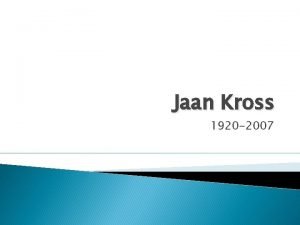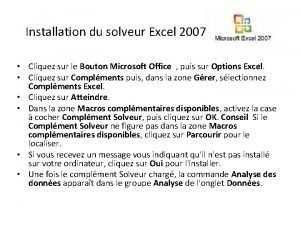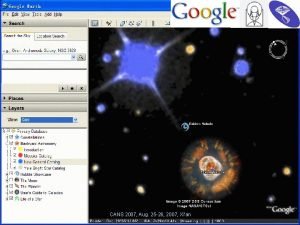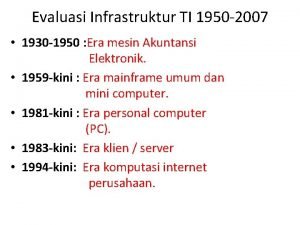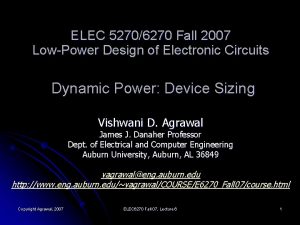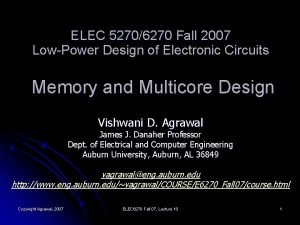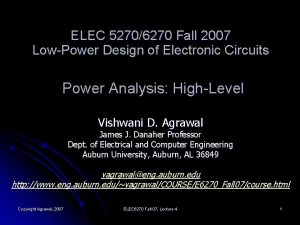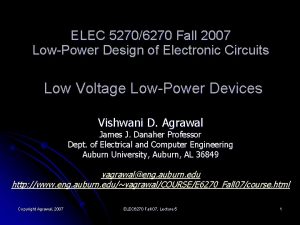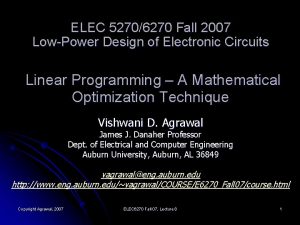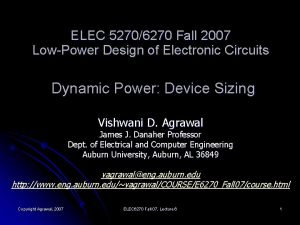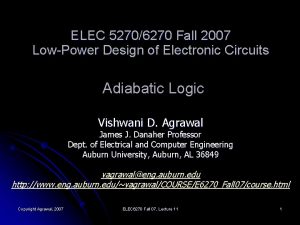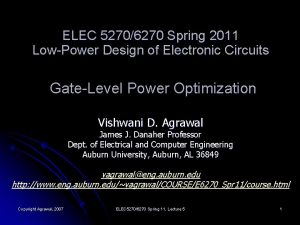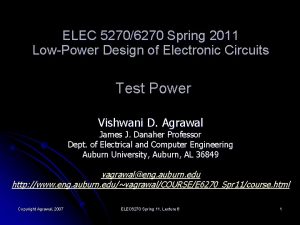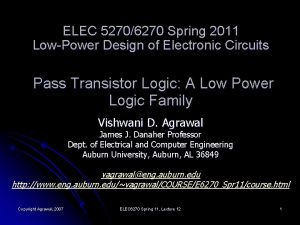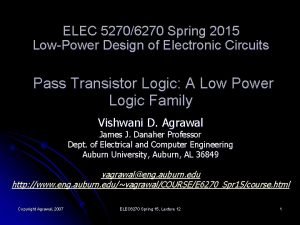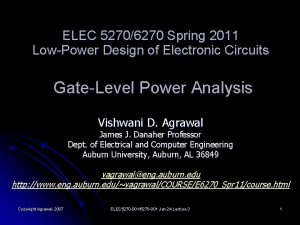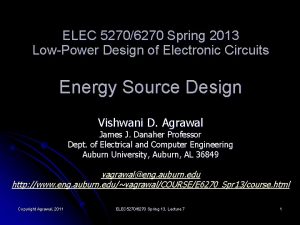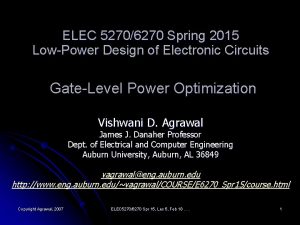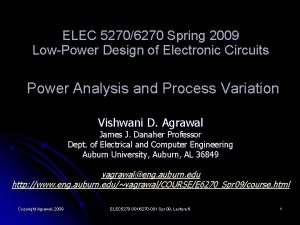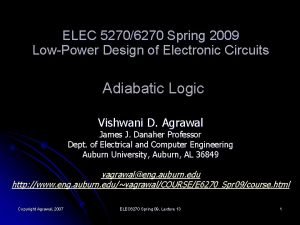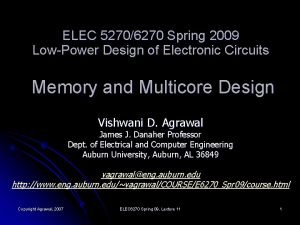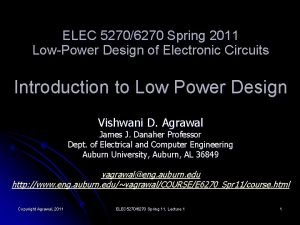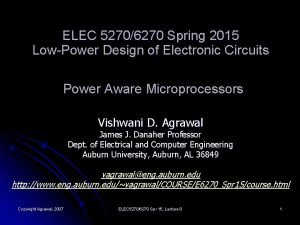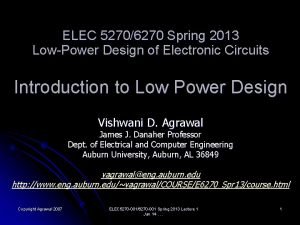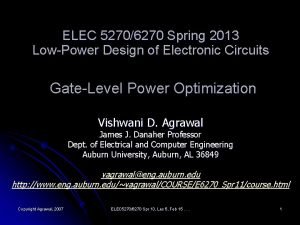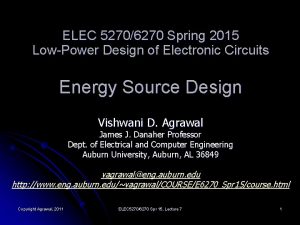ELEC 52706270 Fall 2007 LowPower Design of Electronic
























































- Slides: 56

ELEC 5270/6270 Fall 2007 Low-Power Design of Electronic Circuits Logic-Level Power Estimation Vishwani D. Agrawal James J. Danaher Professor Dept. of Electrical and Computer Engineering Auburn University, Auburn, AL 36849 vagrawal@eng. auburn. edu http: //www. eng. auburn. edu/~vagrawal/COURSE/E 6270_Fall 07/course. html Copyright Agrawal, 2007 ELEC 6270 Fall 07, Lecture 3 1

Power Analysis l Motivation: l Specification l Optimization l Reliability l Applications l Design analysis and optimization l Physical design l Packaging l Test Copyright Agrawal, 2007 ELEC 6270 Fall 07, Lecture 3 2

Abstraction, Complexity, Accuracy Abstraction level Algorithm Computing resources Analysis accuracy Least Worst Most Best Software and system Hardware behavior Register transfer Logic Circuit Device Copyright Agrawal, 2007 ELEC 6270 Fall 07, Lecture 3 3

Spice l Circuit/device level analysis Circuit modeled as network of transistors, capacitors, resistors and voltage/current sources. l Node current equations using Kirchhoff’s current law. l Average and instantaneous power computed from supply voltage and device current. l l Analysis is accurate but expensive l l Used to characterize parts of a larger circuit. Original references: L. W. Nagel and D. O. Pederson, “SPICE – Simulation Program With Integrated Circuit Emphasis, ” Memo ERL-M 382, EECS Dept. , University of California, Berkeley, Apr. 1973. l L. W. Nagel, SPICE 2, A Computer program to Simulate Semiconductor Circuits, Ph. D Dissertation, University of California, Berkeley, May 1975. l Copyright Agrawal, 2007 ELEC 6270 Fall 07, Lecture 3 4

Logic Model of MOS Circuit p. MOS FETs a b VDD Ca c Cc Cb n. MOS FETs Cd Ca , Cb , Cc and Cd are node capacitances Copyright Agrawal, 2007 a Da b Db c Dc Da and Db are interconnect or propagation delays Dc is inertial delay of gate ELEC 6270 Fall 07, Lecture 3 5

Spice Characterization of a 2 -Input NAND Gate Input data pattern Delay (ps) Dynamic energy (p. J) a=b=0→ 1 69 1. 55 a = 1, b = 0 → 1 62 1. 67 a = 0 → 1, b = 1 50 1. 72 a=b=1→ 0 35 1. 82 a = 1, b = 1 → 0 76 1. 39 a = 1 → 0, b = 1 57 1. 94 Copyright Agrawal, 2007 ELEC 6270 Fall 07, Lecture 3 6

Spice Characterization (Cont. ) Input data pattern Static power (p. W) a=b=0 5. 05 a = 0, b = 1 13. 1 a = 1, b = 0 5. 10 a=b=1 28. 5 Copyright Agrawal, 2007 ELEC 6270 Fall 07, Lecture 3 7

Switch-Level Partitioning l l Circuit partitioned into channel-connected components for Spice characterization. Reference: R. E. Bryant, “A Switch-Level Model and Simulator for MOS Digital Systems, ” IEEE Trans. Computers, vol. C-33, no. 2, pp. 160 -177, Feb. 1984. Internal switching nodes not seen by logic simulator Copyright Agrawal, 2007 G 2 G 1 G 3 ELEC 6270 Fall 07, Lecture 3 8

Delay and Discrete-Event Simulation Inputs (NAND gate) Transient region a b c (CMOS) Logic simulation c (zero delay) c (unit delay) X c (multiple delay) Unknown (X) c (minmax delay) 0 Copyright Agrawal, 2007 5 ELEC 6270 Fall 07, Lecture 3 rise=5, fall=5 min =2, max =5 Time units 9

Event-Driven Simulation Example Scheduled events 2 e =1 g =1 2 2 d=0 4 b =1 f =0 Time stack a =1 c =1→ 0 t=0 1 2 3 4 5 6 7 8 Activity list c=0 d, e d = 1, e = 0 f, g g=0 f=1 g g=1 g 0 Copyright Agrawal, 2007 4 8 Time, t ELEC 6270 Fall 07, Lecture 3 10

Time Wheel (Circular Stack) Current time pointer max t=0 1 Event link-list 2 3 4 5 6 7 Copyright Agrawal, 2007 ELEC 6270 Fall 07, Lecture 3 11

Gate-Level Power Analysis l Pre-simulation analysis: l Partition circuit into channel connected gate components. l Determine node capacitances from layout analysis (accurate) or from wire-load model* (approximate). l Determine dynamic and static power from Spice for each gate. l Determine gate delays using Spice or Elmore delay model. * Wire-load model estimates capacitance of a net by its pin-count. See Yeap, p. 39. Copyright Agrawal, 2007 ELEC 6270 Fall 07, Lecture 3 12

Elmore Delay Model l W. Elmore, “The Transient Response of Damped Linear Networks with Particular Regard to Wideband Amplifiers, ” J. Appl. Phys. , vol. 19, no. 1, pp. 55 -63, Jan. 1948. 2 R 2 C 2 1 R 1 s 4 R 4 C 1 Shared resistance: C 4 R 3 3 C 3 R 45 = R 1 + R 3 R 15 = R 1 R 34 = R 1 + R 3 Copyright Agrawal, 2007 R 5 5 C 5 ELEC 6270 Fall 07, Lecture 3 13

Elmore Delay Formula N Delay at node k = 0. 69 Σ Cj × Rjk j=1 where N = number of capacitive nodes in the network Example: Delay at node 5 = 0. 69[R 1 C 1 + R 1 C 2 + (R 1+R 3)C 3 + (R 1+R 3)C 4 + (R 1+R 3+R 5)C 5] Copyright Agrawal, 2007 ELEC 6270 Fall 07, Lecture 3 14

Gate-Level Power Analysis (Cont. ) l l Run discrete-event (event-driven) logic simulation with a set of input vectors. Monitor the toggle count of each net and obtain capacitive power dissipation: Pcap = Σ Ck V 2 f all nodes k l Where: Ck is the total node capacitance being switched, as determined by the simulator. l V is the supply voltage. l f is the clock frequency, i. e. , the number of vectors applied per unit time l Copyright Agrawal, 2007 ELEC 6270 Fall 07, Lecture 3 15

Gate-Level Power Analysis (Cont. ) l Monitor dynamic energy events at the input of each gate and obtain internal switching power dissipation: Pint = Σ Σ E(g, e) F(g, e) gates g events e l Where l E(g, e) = energy of event e of gate g, pre-computed from Spice. l F(g, e) = occurrence frequency of the event e at gate g, observed by logic simulation. Copyright Agrawal, 2007 ELEC 6270 Fall 07, Lecture 3 16

Gate-Level Power Analysis (Cont. ) l Monitor the static power dissipation state of each gate and obtain the static power dissipation: Pstat = Σ gates g l Σ P(g, s) T(g, s)/ T states s Where P(g, s) = static power dissipation of gate g for state s, obtained from Spice. l T(g, s) = duration of state s at gate g, obtained from logic simulation. l T = vector period. l Copyright Agrawal, 2007 ELEC 6270 Fall 07, Lecture 3 17

Gate-Level Power Analysis l Sum up all three components of power: l P = Pcap + Pint + Pstat References: A. Deng, “Power Analysis for CMOS/Bi. CMOS Circuits, ” Proc. International Workshop Low Power Design, 1994. l J. Benkoski, A. C. Deng, C. X. Huang, S. Napper and J. Tuan, “Simulation Algorithms, Power Estimation and Diagnostics in Power. Mill, ” Proc. PATMOS, 1995. l C. X. Huang, B. Zhang, A. C. Deng and B. Swirski, “The Design and Implementation of Power. Mill, ” Proc. International Symp. Low Power Design, 1995, pp. 105 -109. l Copyright Agrawal, 2007 ELEC 6270 Fall 07, Lecture 3 18

Probabilistic Analysis l View signals as a random processes Prob{s(t) = 1} = p 1 p 0 = 1 – p 1 C 0→ 1 transition probability = (1 – p 1) p 1 Power, P = (1 – p 1) p 1 CV 2 fck Copyright Agrawal, 2007 ELEC 6270 Fall 07, Lecture 3 19

Source of Inaccuracy p 1 = 0. 5 P = 0. 5 CV 2 fck 1/fck p 1 = 0. 5 P = 0. 33 CV 2 fck p 1 = 0. 5 P = 0. 167 CV 2 fck Observe that the formula, Power, P = (1 – p 1) p 1 C V 2 fck , is not Correct. Copyright Agrawal, 2007 ELEC 6270 Fall 07, Lecture 3 20

Switching Frequency Number of transitions per unit time: T = N(t) ─── t For a continuous signal: T = lim t→∞ N(t) ─── t T is defined as transition density. Copyright Agrawal, 2007 ELEC 6270 Fall 07, Lecture 3 21

Static Signal Probabilities l Observe signal for interval t 0 + t 1 l Signal is 1 for duration t 1 l Signal is 0 for duration t 0 l Signal probabilities: l l p 1 = t 1/(t 0 + t 1) p 0 = t 0/(t 0 + t 1) = 1 – p 1 Copyright Agrawal, 2007 ELEC 6270 Fall 07, Lecture 3 22

Static Transition Probabilities l Transition probabilities: l l T 01 = p 0 Prob{signal is 1 | signal was 0} = p 0 p 1 T 10 = p 1 Prob{signal is 0 | signal was 1} = p 1 p 0 T = T 01 + T 10 = 2 p 0 p 1 = 2 p 1 (1 – p 1) Transition density: T = 2 p 1 (1 – p 1) Copyright Agrawal, 2007 ELEC 6270 Fall 07, Lecture 3 23

Static Transition Frequency f = p 1(1 – p 1) 0. 25 0. 2 0. 1 0. 0 0 Copyright Agrawal, 2007 0. 25 0. 5 p 1 ELEC 6270 Fall 07, Lecture 3 0. 75 1. 0 24

Inaccuracy in Transition Density p 1 = 0. 5 T = 1. 0 1/fck p 1 = 0. 5 T = 4/6 p 1 = 0. 5 T = 1/6 Observe that the formula, T = 2 p 1 (1 – p 1), is not correct. Copyright Agrawal, 2007 ELEC 6270 Fall 07, Lecture 3 25

Cause for Error and Correction Probability of transition is not independent of the present state of the signal. l Determine probability p 01 of a 0→ 1 transition. l Recognize p 01 ≠ p 0 × p 1 l We obtain p 1 = (1 – p 1)p 01 + p 11 p 01 p 1 = ───── 1 – p 11 + p 01 l Copyright Agrawal, 2007 ELEC 6270 Fall 07, Lecture 3 26

Correction (Cont. ) Since p 11 + p 10 = 1, i. e. , given that the signal was previously 1, its present value can be either 1 or 0. l Therefore, p 01 p 1 = ────── p 10 + p 01 This uniquely gives signal probability as a function of transition probabilities. l Copyright Agrawal, 2007 ELEC 6270 Fall 07, Lecture 3 27

Transition and Signal Probabilities p 01 = p 10 = 0. 5 p 1 = 0. 5 1/fck p 01 = p 10 = 1/3 p 1 = 0. 5 p 01 = p 10 = 1/6 p 1 = 0. 5 Copyright Agrawal, 2007 ELEC 6270 Fall 07, Lecture 3 28

Probabilities: p 0, p 1, p 00, p 01, p 10, p 11 l l l p 01 + p 00 =1 p 11 + p 10 = 1 p 0=1–p 1 p 01 p 1 = ─────── p 10 + p 01 Copyright Agrawal, 2007 ELEC 6270 Fall 07, Lecture 3 29

Transition Density l T = 2 p 1 (1 – p 1) = p 01 + p 10 = 2 p 10 p 01 / (p 10 + p 01) = 2 p 10 = 2 p 01 Copyright Agrawal, 2007 ELEC 6270 Fall 07, Lecture 3 30

Power Calculation Power can be estimated if transition density is known for all signals. l Calculation of transition density requires l l Signal probabilities l Transition densities for primary inputs; computed from vector statistics Copyright Agrawal, 2007 ELEC 6270 Fall 07, Lecture 3 31

Signal Probabilities x 1 x 2 x 1 + x 2 – x 1 x 2 1 - x 1 Copyright Agrawal, 2007 ELEC 6270 Fall 07, Lecture 3 32

Signal Probabilities x 1 x 2 x 3 X 1 0 0 1 1 0. 5 x 1 x 2 0. 25 0. 625 0. 5 X 2 0 0 1 1 Copyright Agrawal, 2007 X 3 0 1 0 1 Y 1 0 1 0 1 1 y = 1 - (1 - x 1 x 2) x 3 = 1 - x 3 + x 1 x 2 x 3 = 0. 625 Ref: K. P. Parker and E. J. Mc. Cluskey, “Probabilistic Treatment of General Combinational Networks, ” IEEE Trans. on Computers, vol. C-24, no. 6, pp. 668670, June 1975. ELEC 6270 Fall 07, Lecture 3 33

Correlated Signal Probabilities x 1 0. 5 x 1 x 2 0. 5 0. 25 x 2 X 1 0 0 1 1 Copyright Agrawal, 2007 X 2 0 1 0. 625? y = 1 - (1 - x 1 x 2) x 2 = 1 – x 2 + x 1 x 2 = 0. 75 (correct value) Y 1 0 1 1 ELEC 6270 Fall 07, Lecture 3 34

Correlated Signal Probabilities x 1 x 2 0. 5 x 1 + x 2 – x 1 x 2 0. 5 0. 75 X 1 0 0 1 1 Copyright Agrawal, 2007 X 2 0 1 0. 375? y = (x 1 + x 2 – x 1 x 2) x 2 = x 1 x 2 + x 2 x 2 – x 1 x 2 x 2 = x 1 x 2 + x 2 – x 1 x 2 = 0. 5 (correct value) Y 0 1 ELEC 6270 Fall 07, Lecture 3 35

Observation l Numerical computation of signal probabilities is accurate for fanout-free circuits. Copyright Agrawal, 2007 ELEC 6270 Fall 07, Lecture 3 36

Remedies Use Shannon’s expansion theorem to compute signal probabilities. l Use Boolean difference formula to compute transition densities. l Copyright Agrawal, 2007 ELEC 6270 Fall 07, Lecture 3 37

Shannon’s Expansion Theorem l l C. E. Shannon, “A Symbolic Analysis of Relay and Switching Circuits, ” Trans. AIEE, vol. 57, pp. 713 -723, 1938. Consider: Boolean variables, X 1, X 2, . . . , Xn l Boolean function, F(X 1, X 2, . . . , Xn) l l l Then F = Xi F(Xi=1) + Xi’ F(Xi=0) Where Xi’ is complement of X 1 l Cofactors, F(Xi=j) = F(X 1, X 2, . . , Xi=j, . . , Xn), j = 0 or 1 l Copyright Agrawal, 2007 ELEC 6270 Fall 07, Lecture 3 38

Expansion About Two Inputs F = Xi. Xj F(Xi=1, Xj=1) + Xi. Xj’ F(Xi=1, Xj=0) + Xi’Xj F(Xi=0, Xj=1) + Xi’Xj’ F(Xi=0, Xj=0) l In general, a Boolean function can be expanded about any number of input variables. l Expansion about k variables will have 2 k terms. l Copyright Agrawal, 2007 ELEC 6270 Fall 07, Lecture 3 39

Correlated Signal Probabilities X 1 X 2 Y = X 1 X 2 + X 2’ X 2 X 1 0 0 1 1 Copyright Agrawal, 2007 X 2 0 1 Y 1 0 1 1 Shannon expansion about the reconverging input, X 2: Y = X 2 Y(X 2 = 1) + X 2’ Y(X 2 = 0) = X 2 (X 1) + X 2’ (1) ELEC 6270 Fall 07, Lecture 3 40

Correlated Signals l When the output function is expanded about all reconverging input variables, All cofactors correspond to fanout-free circuits. l Signal probabilities for cofactor outputs can be calculated without error. l A weighted sum of cofactor probabilities gives the correct probability of the output. l l For two reconverging inputs: f = xixj f(Xi=1, Xj=1) + xi(1 -xj) f(Xi=1, Xj=0) + (1 -xi)xj f(Xi=0, Xj=1) + (1 -xi)(1 -xj) f(Xi=0, Xj=0) Copyright Agrawal, 2007 ELEC 6270 Fall 07, Lecture 3 41

Correlated Signal Probabilities X 1 X 2 Y = X 1 X 2 + X 2’ X 2 X 1 0 0 1 1 X 2 0 1 Y 1 0 1 1 Shannon expansion about the reconverging input, X 2: Y = X 2 Y(X 2=1) + X 2’ Y(X 2=0) = X 2 (X 1) + X 2’ (1) y = x 2 (0. 5) + (1 -x 2) (1) = 0. 5 (0. 5) + (1 -0. 5) (1) = 0. 75 Copyright Agrawal, 2007 ELEC 6270 Fall 07, Lecture 3 42

Example 0. 5 1 0 0. 5 Reconv. signal Supergate 0. 25 0. 0 Point of reconv. 0. 0 0. 5 1. 0 0. 375 Signal probability for supergate output = 0. 5 Prob{rec. signal = 1} + 1. 0 Prob{rec. signal = 0} = 0. 5 × 0. 5 + 1. 0 × 0. 5 = 0. 75 S. C. Seth and V. D. Agrawal, “A New Model for Computation of Probabilistic Testability in Combinational Circuits, ” Integration, the VLSI Journal, vol. 7, no. 1, pp. 49 -75, April 1989. Copyright Agrawal, 2007 ELEC 6270 Fall 07, Lecture 3 43

Probability Calculation Algorithm l Partition circuit into supergates. l l l Definition: A supergate is a circuit partition with a single output such that all fanouts that reconverge at the output are contained within the supergate. Identify reconverging and non-reconverging inputs of each supergate. Compute signal probabilities from PI to PO: l For a supergate whose input probabilities are known Enumerate reconverging input states l For each input state do gate by gate probability computation l Sum up corresponding signal probabilities, weighted by state probabilities l Copyright Agrawal, 2007 ELEC 6270 Fall 07, Lecture 3 44

Calculating Transition Density . . . x 1, T 1 xn, Tn Copyright Agrawal, 2007 1 Boolean function y, T(Y) = ? n ELEC 6270 Fall 07, Lecture 3 45

Boolean Difference Boolean diff(Y, Xi) = l l l ∂Y ── = Y(Xi=1) ⊕ Y(Xi=0) ∂Xi Boolean diff(Y, Xi) = 1 means that a path is sensitized from input Xi to output Y. Prob(Boolean diff(Y, Xi) = 1) is the probability of transmitting a toggle from Xi to Y. Probability of Boolean difference is determined from the probabilities of cofactors of Y with respect to Xi. F. F. Sellers, M. Y. Hsiao and L. W. Bearnson, “Analyzing Errors with the Boolean Difference, ” IEEE Trans. on Computers, vol. C-17, no. 7, pp. 676 -683, July 1968. Copyright Agrawal, 2007 ELEC 6270 Fall 07, Lecture 3 46

Transition Density n T(y) = Σ T(Xi) Prob(Boolean diff(Y, Xi) = 1) i=1 F. Najm, “Transition Density: A New Measure of Activity in Digital Circuits, ” IEEE Trans. CAD, vol. 12, pp. 310 -323, Feb. 1993. Copyright Agrawal, 2007 ELEC 6270 Fall 07, Lecture 3 47

Power Computation l l l For each primary input, determine signal probability and transition density for given vectors. For each internal node and primary output Y, find the transition density T(Y), using supergate partitioning and the Boolean difference formula. Compute power, P= Σ 0. 5 CY V 2 T(Y) all Y where CY is the capacitance of node Y and V is supply voltage. Copyright Agrawal, 2007 ELEC 6270 Fall 07, Lecture 3 48

Transition Density and Power X 1 X 2 X 3 0. 2, 1 0. 3, 2 0. 06, 0. 7 0. 436, 3. 24 Ci Y 0. 4, 3 CY Transition density Signal probability Power = 0. 5 V 2 (0. 7 Ci + 3. 24 CY) Copyright Agrawal, 2007 ELEC 6270 Fall 07, Lecture 3 49

Prob. Method vs. Logic Sim. Circuit Logic Simulation No. of Probability method gates Av. density CPU s* Error % C 432 160 3. 46 0. 52 3. 39 63 +2. 1 C 499 202 11. 36 0. 58 8. 57 241 +29. 8 C 880 383 2. 78 1. 06 3. 25 132 -14. 5 C 1355 346 4. 19 1. 39 6. 18 408 -32. 2 C 1908 880 2. 97 2. 00 5. 01 464 -40. 7 C 2670 1193 3. 50 3. 45 4. 00 619 -12. 5 C 3540 1669 4. 47 3. 77 4. 49 1082 -0. 4 C 5315 2307 3. 52 6. 41 4. 79 1616 -26. 5 C 6288 2406 25. 10 5. 67 34. 17 31057 -26. 5 3. 83 9. 85 5. 08 2713 -24. 2 C 7552 3512 * CONVEX c 240 Copyright Agrawal, 2007 ELEC 6270 Fall 07, Lecture 3 50

Probability Waveform Methods l l F. Najm, R. Burch, P. Yang and I. Hajj, “CREST – A Current Estimator for CMOS Circuits, ” Proc. IEEE Int. Conf. on CAD, Nov. 1988, pp. 204 -207. C. -S. Ding, et al. , “Gate-Level Power Estimation using Tagged Probabilistic Simulation, ” IEEE Trans. on CAD, vol. 17, no. 11, pp. 1099 -1107, Nov. 1998. F. Hu and V. D. Agrawal, “Dual-Transition Glitch Filtering in Probabilistic Waveform Power Estimation, ” Proc. IEEE Great Lakes Symp. VLSI, Apr. 2005, pp. 357 -360. F. Hu and V. D. Agrawal, “Enhanced Dual-Transition Probabilistic Power Estimation with Selective Supergate Analysis, ” Proc. IEEE Int. Conf. Computer Design, Oct. 2005. pp. 366 -369. Copyright Agrawal, 2007 ELEC 6270 Fall 07, Lecture 3 51

Problem 1 For equiprobable inputs analyze the 0→ 1 transition probabilities of all gates in the two implementations of a four-input AND gate shown below. Assuming that the gates have zero delays, which implementation will consume less average dynamic power? E A B C D F G A B C D G F Tree structure Chain structure Copyright Agrawal, 2007 E ELEC 6270 Fall 07, Lecture 3 52

Problem 1 Solution Given the primary input probabilities, P(A) = P(B) = P(C) = P(D) = 0. 5, signal and transition (0→ 1) probabilities are as follows: Chain Tree Signal name Prob(sig. = 1) Prob(0→ 1) Prob(sig. =1) Prob(0→ 1) E 0. 2500 0. 1875 F 0. 1250 0. 1094 0. 2500 0. 1875 G 0. 0625 0. 0586 Total transitions/vector 0. 3555 0. 4336 The tree implementation consumes 100×(0. 4336 – 0. 3555)/0. 3555 = 22% more average dynamic power. This advantage of the chain structure may be somewhat reduced because of glitches caused by unbalanced path delays. Copyright Agrawal, 2007 ELEC 6270 Fall 07, Lecture 3 53

Problem 2 Assume that the two-input AND gates in Problem 1 each has one unit of delay. Find input vector pairs for each implementation that will consume the peak dynamic power. Which implementation consumes less peak dynamic power? E A B C D F G A B C D G F Tree structure Chain structure Copyright Agrawal, 2007 E ELEC 6270 Fall 07, Lecture 3 54

Problem 2 Solution For the chain structure, a vector pair {A B C D} = {1110}, {1011} will produce four gate transitions as shown below. A E F B C D G A=11 B=10 E=10 C=11 F=10 D=01 G=00 0 Copyright Agrawal, 2007 1 2 3 ELEC 6270 Fall 07, Lecture 3 Time units 55

Problem 2 Solution (Cont. ) The tree structure has balanced delay paths. So it cannot make more than 3 gate transitions. A vector pair {ABCD} = {1111}, {1010} will produce three transitions as shown below. A E B G C D F A=11 Therefore, just counting the gate transitions, we find that the chain consumes 100(4 – 3)/3 = 33% higher peak power than the tree. B=10 E=10 C=11 D=10 F=10 G=10 0 1 2 Copyright Agrawal, 2007 3 Time units ELEC 6270 Fall 07, Lecture 3 56
 Elec 4601
Elec 4601 Elec4601
Elec4601 Keesmel
Keesmel Elec
Elec Dec alpha 21264
Dec alpha 21264 Elec
Elec Saif zahir
Saif zahir Superposition electric circuits
Superposition electric circuits An electronic is the electronic exchange of money or scrip
An electronic is the electronic exchange of money or scrip Electronic field production
Electronic field production Design of gantry girder as per is 800 2007
Design of gantry girder as per is 800 2007 Electronic design automation course
Electronic design automation course System level design
System level design Maziar goudarzi
Maziar goudarzi Ribbon untuk memulai vba excel adalah
Ribbon untuk memulai vba excel adalah Excel
Excel Mental health act 2007 summary
Mental health act 2007 summary Delhi fire service act 2007
Delhi fire service act 2007 Df 24/1997
Df 24/1997 Tarikh puasa 2007
Tarikh puasa 2007 Dijana dominis prester
Dijana dominis prester How to create multiple choice questions in word 2007
How to create multiple choice questions in word 2007 Sale of goods and supply of services act 1980
Sale of goods and supply of services act 1980 June 2007 physics regents
June 2007 physics regents Power pivot
Power pivot Inei censo 2007 resultados
Inei censo 2007 resultados Summary of public procurement act 2007
Summary of public procurement act 2007 Ods to excel
Ods to excel Tombol size button terletak di bagian pojok
Tombol size button terletak di bagian pojok Office project 2007
Office project 2007 Breakdown visio
Breakdown visio Publisher 2007
Publisher 2007 Curso word 2007
Curso word 2007 Maturita 2006
Maturita 2006 The heavenly banquet
The heavenly banquet Lineamientos de reforma del sector salud
Lineamientos de reforma del sector salud Lei 171 de 2007
Lei 171 de 2007 Sentenze gemelle 348 e 349 del 2007
Sentenze gemelle 348 e 349 del 2007 Mityc envio precios
Mityc envio precios Keputusan menteri pupr no 1044/kpts/m/2018
Keputusan menteri pupr no 1044/kpts/m/2018 Jaan krossi luulekogu
Jaan krossi luulekogu Kirjanik 1920-2007
Kirjanik 1920-2007 Ms project 2007
Ms project 2007 Ms word 2007 view tab
Ms word 2007 view tab Installer solveur excel
Installer solveur excel Tabla de contenido word 2013
Tabla de contenido word 2013 Putting people first 2007
Putting people first 2007 D lgs 231/2007
D lgs 231/2007 Microsoft office 2007 wiki
Microsoft office 2007 wiki Mail merge word 2007
Mail merge word 2007 Power failure andrew forster
Power failure andrew forster Google sky 2007
Google sky 2007 Plastic prints
Plastic prints Goal seek algorithm
Goal seek algorithm Solver excel 2007
Solver excel 2007 Visual basic excel 2007
Visual basic excel 2007 2007-1930
2007-1930
